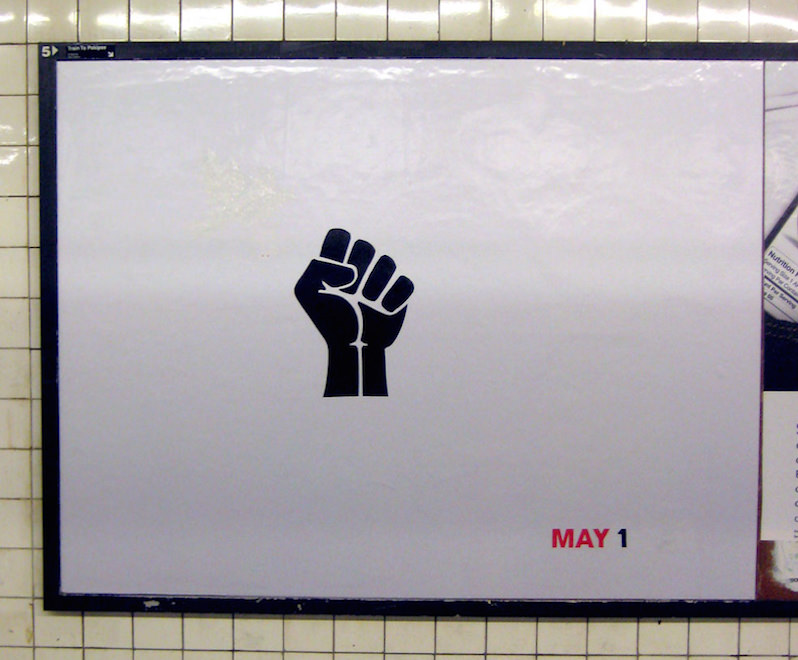The Many-Sided, Overlapping Meanings of May Day
The working-class holiday has Marxist and anarchist industrial-era roots, but the significance of May 1 goes deeper than that. A 2012 May Day poster in New York City. (Poster Boy / CC BY-SA 2.0)
A 2012 May Day poster in New York City. (Poster Boy / CC BY-SA 2.0)
May Day, or May 1, has many meanings, in my experience. When I was a grade-schooler in Chicago, it was the day on which the officially Marxist-Leninist Soviet Union paraded its military might in Moscow’s Red Square. It was a reminder that there was another military superpower on the planet besides the United States.
The Workers Day: Red and Black
Only later did I learn that May Day’s real left origins were in the older revolutionary socialist- and anarchist-led struggle of the U.S. working class for an eight-hour day. Targeting May 1 as the day for the introduction of shorter hours, activists brought the issue to a boiling point in Chicago in the spring of 1886. The fight culminated in the fateful tossing of the Haymarket bomb, the savage execution of four of the city’s great radical leaders—“the Haymarket Martyrs”—and a great wave of anti-union and anti-left repression across the nation.
May 1 became an international day of working-class and left protest in subsequent years. Well into the 20th century, leftist May Day speakers and banners would repeat Karl Marx and Frederick Engels’ maxims: “The working men have no country. … Workers of the world unite.”
The Soviets and other communist nations in the post-World War II era appropriated the international proletarian tradition, marking May 1 an official holiday to demonstrate the power of their nationally specific arsenals and troops—marshaled to keep U.S.-led capitalist imperialism at bay.
It might at first seem odd that radical anarchists and Marxists placed such strong emphasis on a day formed largely around a struggle for reform under capitalism—a shorter workday with no reduction in income. But left working-class militants in the late 19th century knew that overwork robbed workers of the time and energy to engage in critical reflection and join movements for resistance to what was then commonly understood to be “wage slavery.” They reasonably saw a reduction of workers’ time spent under the bosses’ lash as an essential step toward the building of anti-capitalist consciousness and struggle. Shorter hours also were meant to force employers to hire more workers and thereby to raise workers’ bargaining power and reduce profits.
The high level of collaboration and ideological cross-fertilization evident between Marxists, left anarchists and trade unionists (what the left historian and lawyer Staughton Lynd has called “the Haymarket Synthesis”) in Chicago’s eight-hour-day movement would not often be replicated in the 20th century. As the radical historian Bruce C. Nelson showed in his masterful 1986 volume “Beyond the Martyrs: A Social History of Chicago’s Anarchists, 1870-1900”, the multiethnic (if largely German-American-led) Chicago left of that time was remarkably eclectic, intellectually fluid and nonsectarian.
Such are the red (Marxist) and black (anarchist) industrial-era roots of May Day, the working-class holiday.
Pre-Modern Roots: Green
May Day has different and older green roots in a time-honored pagan celebration of nature’s beauty and fertility amid spring’s full flowering and the onset of summer in northern temperate zones. Dating to ancient Rome, this May Day is rooted in the seasonal rhythms of Mother Earth and agriculture. It reached across the Atlantic with the European conquest of what became known as the Americas. It is a day of leisure, to be spent outdoors, dancing and wearing flowers. While rooted in custom, it was an official holiday in the British Tudor monarchy by at least the early 16th century. (The bourgeois-revolutionary Puritan Parliaments of 1649-1660 suspended the holiday, which was reinstated with the restoration of Charles II.)
Red and Green Common Ground
It is not hard to imagine the ancient green May Day merging with the modern red and black proletarian May Day. “Eight Hours for What We Will,” union banners proclaimed in 1886. “For what we will” included time out of doors, in the free-flowing presence of nature, beyond the dirty, dangerous and depressing mills, mines and factories of Dickensian and Gilded Age capitalism—and away from the rigid “time-work discipline” (a term coined by British historian E.P. Thompson) imposed by despotic employers in what Marx called “the hidden abode of production.” It was an era when many, perhaps most, wage-earners retained connections to pre-industrial and more communalist and rural ways of life.
The workers movements of 19th century North America drew on the rolling, recurrently immigration-fed tension between pre-industrial agricultural and artisanal ways of life on one hand and the authoritarian, speeded-up and nonstop “jungle” (detailed by American author Upton Sinclair) of industrial capitalist “modernity” on the other.
One delicious connection is that the eight-hour-day struggle in Chicago was particularly focused on the city’s McCormick Harvesting Machine Co. plant, manufacturer of a farm technology that famously displaced millions of laborers from agricultural work while helping industrialize the North American and global countryside.
Consistent with this melding of the red and green May Days, “modern” capitalism assaulted nature and created the wage-dependent proletariat at one and the same time through the long enclosure of “the commons.” The commons are the vast swaths of land, stream and forest in which pre-capitalist people found sustenance, insulating them from having to rent out their labor power to capitalists to garner the money required to purchase life’s necessities as commodities. As the brilliant left historian Peter Linebaugh notes in his book “Stop Thief!” “A single term, ‘the commons,’ expresses, first, that which the working class lost when subsistence resources were taken away, and, second, the idealized visions of liberté, egalité, fraternité,”
Rooted in a vast human history that long predated the ascendancy of “the commodity with its individualism and privatization,” the commons, Linebaugh writes, “is antithetical to capital.” The Protestant radical group known as Diggers and others with roots in the village commons who opposed capital’s rise to supremacy understood that “expropriation leads to exploitation, the Haves and the Have Nots.”
The Diggers, the first modern communists, were led by Gerrard Winstanley. They sought to pre-empt the coming new soulless wage, money and commodity slavery of the capitalist order (the bourgeois regime that Marx and Engels would justly accuse of “resolv[ing] personal worth into exchange value”) by claiming earth as “a common treasury for all.” Writing as England was becoming the first fully capitalist nation where most of the adult working-age population toiled for wages, Winstanley and his followers practiced what Linebaugh calls “commoning,” the merging of “labor” and “natural resources” in the spirit of “all for one and one for all.”May Day is an official holiday now in many European nations, with its meaning generally understood to combine the pre-modern folk roots and, however diluted, the modern labor and left origins.
”Loyalty” and “Law Day”
The green-red May Day has been considered threatening enough to capitalist interests for U.S. presidents to intercede against it. In 1894, Grover Cleveland tried to take the steam out of the spring workers day and, more importantly, to “de-escalate class tensions” after that year’s nationwide Pullman Strike by proclaiming the first Monday in September “Labor Day,” wrote Jonah Walters, a researcher at Jacobin magazine.
In 1958, during the Cold War, President Dwight Eisenhower signed a resolution naming May 1 “Loyalty Day” to discourage any hint of solidarity with the “workers of the world.” The resolution declared May 1 “a special day for the reaffirmation of loyalty to the United States of America and for the recognition of the heritage of American freedom.”
That same year, Eisenhower proclaimed May 1 “Law Day” to honor “the rule of law” over and against the rule of force. To this day, many local bar and legal educational associations use the day to educate students about the virtuous power of bourgeois law.
Springtime for Hitler
Speaking of the rule of force, the ultimate reactionary appropriation took place in Nazi Germany. Adolf Hitler found an interesting use for May Day in a May 1, 1933, speech, establishing it as a paid holiday for the celebration of workers and work across Germany. In his address, then-German Chancellor Hitler cleverly pitted the ancient green May Day against the modern red May Day to trump class conflict with common allegiance to the “iron fist” of the “volk”-based national state. Hitler sought to move Germany off the “tired dogma” of Marxism and into national superproductivity on behalf of a properly class-ranked fatherland, rooted in the glorious traditions of the great Nordic “volk”:
German Volk, you are strong when you are one. … For many centuries, the first day of May was … symbolic of spring’s arrival in the countryside; it was also a day of joy, of festive spirits and sentiments. …There came a time when this day was enlisted [by Marxists] for other purposes, and the day of new life and hopeful joy was transformed into a day of quarrel and internal strife. A dogma which had seized hold of our Volk … this day seemed more and more destined to document the division and disunity of our Volk. But there finally came a time of reflection … for German people to come together again. … And today we can once more join in singing the old folk song: “Der Mai ist gekommen.” Our Volk’s awakening has come to pass. The symbol of class conflict, of never-ending strife and discord, is now becoming once again the symbol of the great unity and uprising of the nation. And thus, for all time to come, we have chosen this day when nature awakens as the day of regaining our own power and strength and, at the same time, the productive work which knows no limits, which is not bound to unions or factories or offices; work we wish to recognize and promote wherever it is performed in a positive sense for the very existence and the life of our Volk.
Perhaps the virulent white nationalist Congressman Steve King would like to update this speech for delivery Monday to his 95 percent white constituents in western Iowa.
Immigrant Rights—2006
Eleven years ago, U.S. immigrant rights activists picked May 1 for mass protests on behalf of the nation’s mostly Mexican-American immigrant workers. This remarkable day enlisted millions from coast to coast. I spoke at one such gathering at Northern Illinois University, where Bruce C. Nelson wrote the dissertation that became “Beyond the Martyrs” in the once Marxist-led history department.
There, in DeKalb, Ill., hundreds of Latino workers employed at the local General Electric plant and in other local industries showed up seemingly out of nowhere in the middle of a workday. These brown-skinned, Spanish-speaking workers lived in the same neighborhoods once inhabited by my white-skinned, May Day-celebrating, Finnish ancestors (the Luhtalas), who migrated hassle-free to work in the town’s steel wire plants a century before.
I was struck by the irony of Mexican and Central American immigrants carrying on the May 1 tradition in a nation that no longer knew about the holiday, even though it had hosted red May Day’s emergence in Chicago. The irony was unsurprising. As the brilliant Australian critic of thought control Alex Carey noted, the United States is historical ground zero for the amnesia-inducing power of corporate propaganda—the art and science of “taking the risk out of democracy.” Historical deletion and distortion is a key part of that, as British author George Orwell knew.
“Mayday! Mayday! Mayday!”
A final meaning of the phrase “Mayday” deserves mention. It was familiar to any American from movies, literature, television and/or comic books when I was a grade-schooler. I am referring to what a pilot says into his radio as his plane plummets to earth: “Mayday! Mayday! Mayday!”
The Hour Is Getting Late
Looking back on these many-sided and overlapping meanings of May Day, I am struck by their essential interrelation and interdependence. We need to work this and coming springs for a radically many-sided May Day, one that takes an “all of the above” approach to these different yet intimately interwoven and dialectically inseparable meanings—rather than the reactionary appropriations, of course.
If I had to choose one of the meanings above all others, I suppose it would be the one that celebrates and venerates nature. This is for the simple materialist reason that if the global environmental catastrophe created by anthropogenic (really, capitalogenic) climate change isn’t averted soon, then, as social critic Noam Chomsky has warned, “in a generation or two, everything else we’re talking about won’t matter.”Spaceship Earth is on exterminist path that is rapidly accelerating, as the latest findings on melting Arctic ice cover, rising global temperature and looming permafrost release regularly tell us. “So let us not talk falsely now,” to quote Bob Dylan, “the hour is getting late.” Check out the latest configuration of the Bulletin of Atomic Scientists’ Doomsday Clock.
Mayday! Mayday! Mayday! Indeed. If the current environmental trajectory is not significantly reversed, the left’s long-standing struggle for equality and democracy is reduced to a debate over how to more equitably share a poisoned pie. Who wants to “turn the world upside down” (Winstanley’s phrase) only to find out that it is a steaming pile of overheated toxic waste? There’s something for workers to control.
A Green Door Painted Red, Black and Brown
But the choice between a green and a red May Day is a false dichotomy. Capital is antithetical to the commons. The capitalist system is addicted to endless chaotic accumulation and to economic “growth” as the false solution to the endemic poverty, inequality and joblessness it chronically generates. It is hard-wired for exterminism. It is “the enemy of nature,” says American author Joel Kovel, and can never be reconciled with the species-wide planning and “commoning” of Linebaugh required to save livable ecology. Transcending commodity rule and private, profit-addicted ownership in the means of production and investment is a prerequisite for saving the environmental basis for a decent future.
It should never be forgotten that capitalism relies on the exploitation of the natural environment every bit as much as it does on the exploitation of labor power. As sociology professor Jason Moore and others have shown, its whole long history of expansion, crisis, retreat and re-expansion is intimately bound up with its recurrent search for new, commons-defiling planetary/geographic frontiers of “cheap nature”: free or cheap energy, raw materials, food and labor power (human nature). That has always made imperialism, capitalism’s evil twin, reminding us that anti-imperialism remains an essential project for those who would rescue a world worth turning upside down.
One of Stalinist Russia’s real accomplishments was to set some spatial limits to the global reach of capital. You don’t have to be aligned with an authoritarian and commons-assaulting entity like the onetime Soviet Union to fight meaningfully to set limits to the now- and long-U.S.-led imperial agenda of endlessly expanding the global “open door” capitalism.
Organizing against capitalist and imperialist ecocide takes time and energy, things that are in short supply for untold millions of heavily overworked and overcommuted Americans. Ask any community organizer about the barrier to activism posed by the exhaustion of many they’d like to enlist in the struggle for a decent and democratic future. The struggle for shorter working hours and for more leisure time for “what we will”—including time to participate meaningfully in political life—continues to hold relevance today. Time is a big democracy issue, something that was very well and centrally understood by the United States’ earliest trade unions.
The 2006 meaning of immigrant rights is also highly pertinent. The stigmatization and oppression of immigrants undermines the working-class solidarity and power that meaningful resistance to capitalism requires. At the same time, nativist scapegoating of immigrants and “foreigners” functions in no small part to divert the native white populations of the U.S. and Europe from focusing on the real source of their economic and political discontent: the profits system. That’s a key function that the Nazis’ demonization of the Jews provided for the German bourgeoisie in the 1930s, with epically disastrous consequences.
Speaking of brown, red and green meanings, this May Day, we might want to recall that North America’s First Nations people were highly civilized, unscathed by capitalist and other forms of class rule and harmoniously connected to the natural environment. As the Native American author and activist Ward Churchill wrote two decades ago:
On October 12, 1492. The day Christopher Columbus first washed up on a Caribbean beach, North America was long since endowed with an abundant and exceedingly complex cluster of civilizations. Having continuously occupied the continent for at least 50,000 years, the native inhabitants evidenced … environmentally sound farming procedures which originated well over half the vegetal foodstuffs now consumed by peoples the world over. By and large, the indigenous societies demonstrating such attainments were organized along extremely egalitarian lines, with real property held collectively and matrifocality a normative standard. War … in the Euro-derived sense in which the term is understood today, was unknown.
Also unknown was economic inequality and poverty on anything remotely like the scale of early modern Europe, which gestated the capitalist order that would spill its surplus onto North American territory, including what would become the United States—a nation where the top tenth of the top 1 percent currently owns more wealth than the bottom 90 percent.
Pre-conquest North American civilization comprised what Churchill described as “large-scale societies which had perfected ways of organizing themselves into psychologically fulfilling wholes, experiencing very high standards of living, and still maintaining environmental harmony.” It was a form of not-so-primitive communism, where “commoning” was common civilizational sense.
The Europeans’ conquest and enclosure of the New World commons spelled genocidal tragedy for the continent’s original inhabitants.
Today, it is clear that the capital-led failure to common is civilizational suicide. We either transcend our various single-issue and sectarian silos (“Haymarket Synthesis” anyone?) and radically merge our struggles around the multiple and interrelated meanings of a many-sided May Day, or it is truly Mayday! Mayday! Mayday!—what Marx (born on May 5) called “the common ruin of all the contending classes”—for one and all.
Your support matters…Independent journalism is under threat and overshadowed by heavily funded mainstream media.
You can help level the playing field. Become a member.
Your tax-deductible contribution keeps us digging beneath the headlines to give you thought-provoking, investigative reporting and analysis that unearths what's really happening- without compromise.
Give today to support our courageous, independent journalists.








You need to be a supporter to comment.
There are currently no responses to this article.
Be the first to respond.